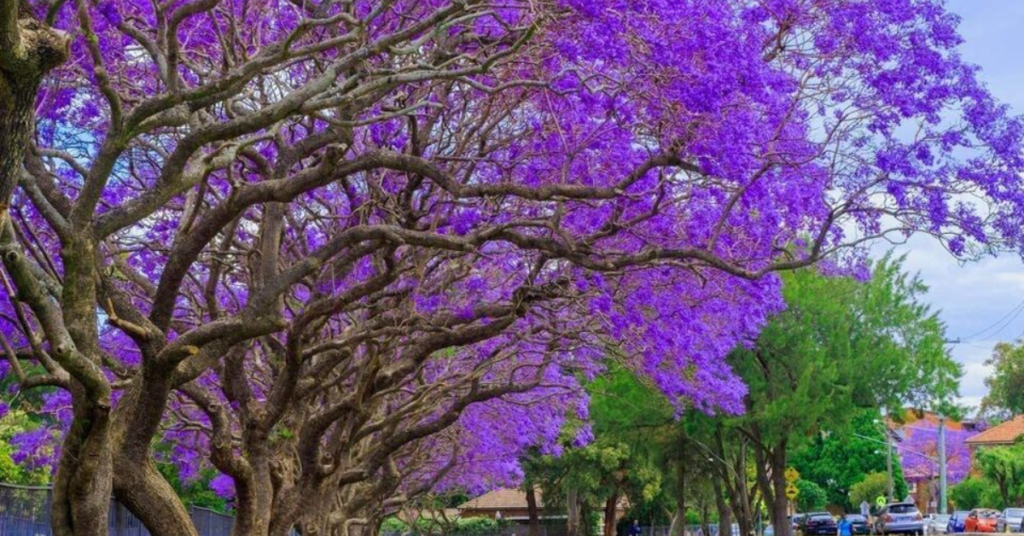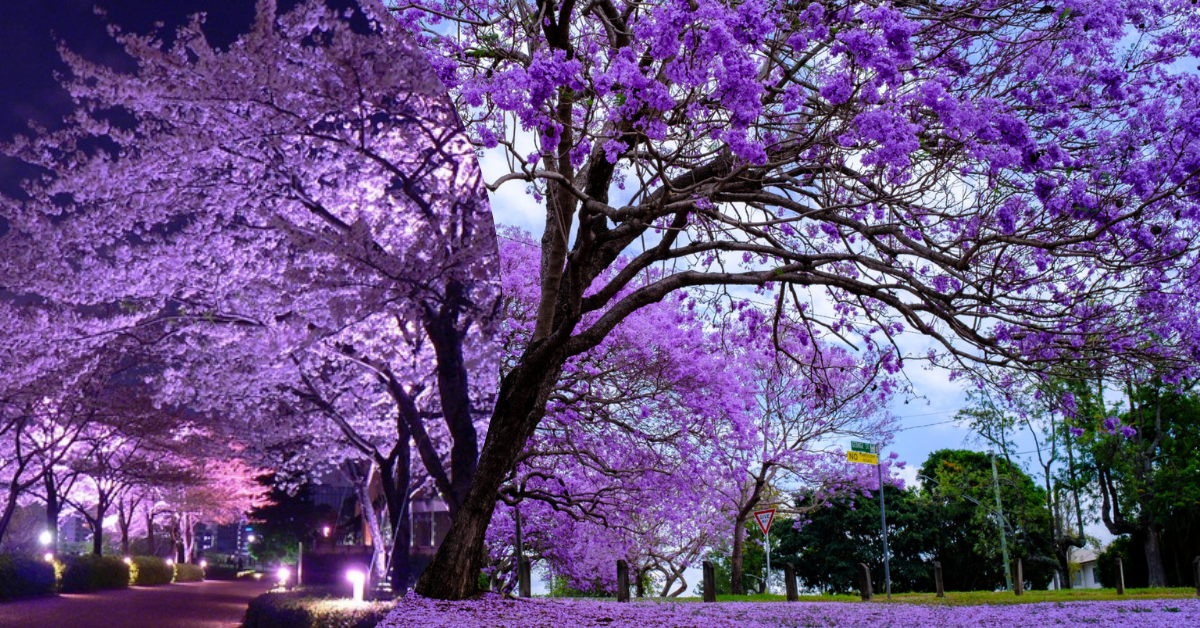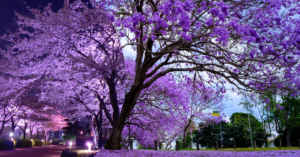Purple Blooming Tree: Nature’s Colorful Surprise
A purple flowering tree is not only a splash of color. But a token of Spring excitement, a delight of those who love gardening, and the eye pleasing of people. Who see such a phenomenon and it turns a rather average piece of land into something very special. Be it a Jane or an Eastern Redbud, they are trees with the bright purple flowers that can make any street. Any backyard, any park look immediately much shinier. In the United States, a purple-blooming tree is an object that people frequently seek. Because of its aesthetic value as well as the character it contributes to the landscape. In this article, we are going to read more about the best varieties, growing tricks and the wizardry of. These beautiful trees with purple flowers.
1. What Makes a Purple Blooming Tree So Special?
It is almost magical when a tree is full of purple flowers. As opposed to typical green leaves or nondescript colored flowers, the bright purples are attention-getting. A purple flowering tree is not only attractive, it is usually a focal point. That everyone will stare at and be amazed. It has an exceptional grace in the contrast of deep purple and the green leaves (or even, the blue sky).
Trees that have purple flowers are labels of creativity, mystery, and spiritual symbolisms culturally. They are useful in landscaping since they can be used to make a boring area into a visual splendor. A purple-blooming tree may be sufficient to lighten up. Any driveway, design a shady place to take an afternoon break or become an Instagram-worthy feature of a garden.
2. Popular Types of Purple Blooming Trees in the U.S.
And in case you want to introduce one of those beauties into your garden. Here are some of the most popular ones all over the U.S.:
- Jacaranda Tree – The jacaranda tree is native to South America and popular in the south. What makes it so special is that the tree blooms purple in clusters and looks absolutely dreamy with its purple flowers carpeting the ground.
- Eastern Redbud-this is a native tree in North America with small flowers that are bright purple- pink early in the spring.
- Chaste Tree (Vitex) – Has fragrant purple flower clusters that are cone-shaped and are pollinator tourist attractions.
- Royal Empress Tree– a quick grower with lush blooms of large trumpet shaped lavender-purple flowers.
All the purple flowering trees possess different growth patterns, growth height, as well as flowering period and so it is up to you to make a choice depending on your local climate and space you have.
3. How to Choose the Right Purple Blooming Tree for Your Yard
The best way to choose the right purple flowering tree is with regard to which area you live. Just because a tree grows in one place does not mean it would grow everywhere so you will need to pair the tree with your USDA/hardiness zone. To take an instance, Jacarandas prefer warmth and grow best in zone 9-11 but Redbuds are more cold hardy and will grow in zone pa 4-9.
Think of size as well, do you want a tall shade tree or a small ornamental one? In addition, consider the level of maintenance and amount of messiness the flowers may cause as well as the duration of the bloom season. You can go to a local nursery and request to get a recommendation by soil recommendation, location over the sun, etc. to make the purchase of a purple blooming tree just right.
4. Planting and Caring for a Purple Blooming Tree
Tending a purple blooming tree is not a difficult task though paying some bit of attention in the initial stages is necessary. Begin by planting them in well draining soil, and a position receiving full to partial sunlight. Too deep though, as root rot and other problems will develop when the plant is too low.
Watering advice: Deeply water the first year to establish roots. Thereafter, the majority of trees that have purple flowers end up being quite drought-resistant.
Fertilizing: Apply well balanced, slow- release fertilizer once a year in early spring to promote vigorous growth with abundant flowers.
Pruning: Clip during late winter or early spring so as to take off the dead or damaged branches and shape the tree.
But a bit of love and patience will be well covered by the beautiful flower production on your purple-blooming tree again and again every year.(Amazon)
5. The Best Time of Year to See a Purple Blooming Tree in Full Glory
Depending on the variety of purple blooming trees found in the United States, timing is also dependent on the particular species but in general, the majority of purple blooming trees bloom in the spring months. A little later, probably late spring and early summer, jacarandas bloom and turn the streets and sidewalks purple.
In case you are shooting to have long periods of blooming, think more about stagger-planting various trees having purple flowers. Thus, one can have unending color, March to July, depending on the site. Make note that to achieve full bloom, one must give constant attention towards the tree and months prior to flowering.

6. Landscaping Ideas Featuring a Purple Blooming Tree
Use your imagination to find a lot of lovely uses of a purple blooming tree in your landscape:
- Make a point of interest in a garden or a front yard.
- The purple will pop when accompanied by white or yellow flowers.
- Arch a driveway or path by planting many trees in a row.
- Apply as a shade-giver to seating sites, patios or hammocks.
- Coupled with lighting so as to bring out the flowers in evenings.
A tree that produces purple flowers can become the center of attention of your garden with no difficulties when smart lighting and a selection of coexisting flora are used.(Visit website for more)
7. Common Problems That Affect Purple Blooming Trees
Even such strong purple blooming trees can have some difficulties. Here are the things to look out:
- Pests: Aphids, scale insects and caterpillars may ruin the leaves and the flowers.
- Diseases: Fungal problems such as powdery mildew or root rot can happen when the tree is not planted in a well-drained soil.
- Environmental stress: Too much ‘cold weather’ or a drought may affect the flowering and health.
Daily check up, adequate watering and periodic plan of applying organic treatment will ensure the purple flowering tree remains green and healthy throughout the year. And keep it in mind that to avoid being at the mercy of diseases, selectively picking disease-resistant species in the first place may take you out of trouble in the future.
8. Why a Purple Blooming Tree Adds More Than Just Color
Yes, it is a beautiful color– but so is a purple blooming tree– a pollinator habitat to bees and butterflies, a cool space on hot days, and some architecture in your backyard. On top of all the physical stuff there is this joyniting emotional feeling to see a tree with purple flowers come out of a long and silent winter and into spring.
The trees may be special, marking birthdays, anniversaries, new homes and can just be something special you do to yourself. The purple blooming tree can either enhance the beauty or serve a purpose in the yard you added to whether you feel beautiful, functional or both.
Conclusion
The fact that a purple flowering tree is much more than an aesthetic is an experience in itself. It gives life, motion, color and energy to any landscape. Since you are planting one to boost your curb value, to get some shade on a hot day, or to invite pollinators, these trees are a smart and fashionable choice. Their beautiful flowers attract attention and the ability to change the mood of a yard or even a neighborhood can transform it.
Fancy Jacaranda down in the South to the adorable Redbud up in the East and Middle West, there seems to be a tree with purple blossoms to fit most American climates and most-sized yards. By only spending a bit of effort on your planting and nurturing, the tree would be able to provide you with beauty and pride to appreciate in the future years. it is more than a plant, it is a living, flowering happening in your life.
Key Takeaways:
- Purple flowering trees are distinctive regarding color and a garden decoration, especially since it is so vivid.
- The amazing varieties available are so numerous, such as Jacaranda or Redbud and Chaste Tree, with different ones having their attractiveness and growing requirements.
- Depending on the solar time zone; space, and sun available; selecting the appropriate tree is a variable factor.
- Simple treatment, such as watering, pruning, and fertilizing, will take a long way to make your tree with purple flowers healthy and beautiful.
- These trees are not just pretty; they are shady, they house, they are interesting to look at during the changing seasons, and even they add some significance emotionally.
Regardless of your location around the U.S., chances are you can find a purple flowering tree which would perform well in your ground, and which would look beautiful in your environment. Therefore, take a plunge, grow something beautiful and allow nature to paint your world purple.
FAQs
1. What is the most popular purple blooming tree in the U.S.?
One of the most popular ones throughout the U.S (and cooler climate areas in particular) is the Eastern Redbud. The Jacaranda is popular in warmer zones such as California and Texas.
2. Can I grow a purple blooming tree in a small yard?
Absolutely! See what space-saving varieties are available such as Dwarf Redbud or Chaste Tree because they still provide dramatic purple flowers.
3. How long does a purple blooming tree stay in bloom?
The majority of them fade in 2 weeks to 4 weeks during spring or early summer. Others such as the Chaste Tree can flower intermittently during the summer given proper treatment.
4. Do trees with purple blooms attract bees or butterflies?
Yes! Their flowers are also very attractive and pollinators are especially attracted to them including bees, butterflies and even hummingbirds.
5. Are purple blooming trees messy or hard to clean up after?
Others lose plenty of petals (the Jacaranda is an example) but many gardeners believe that the purple carpet is worth the loss. That is to say, consistent raking keeps things clean.






Post Comment